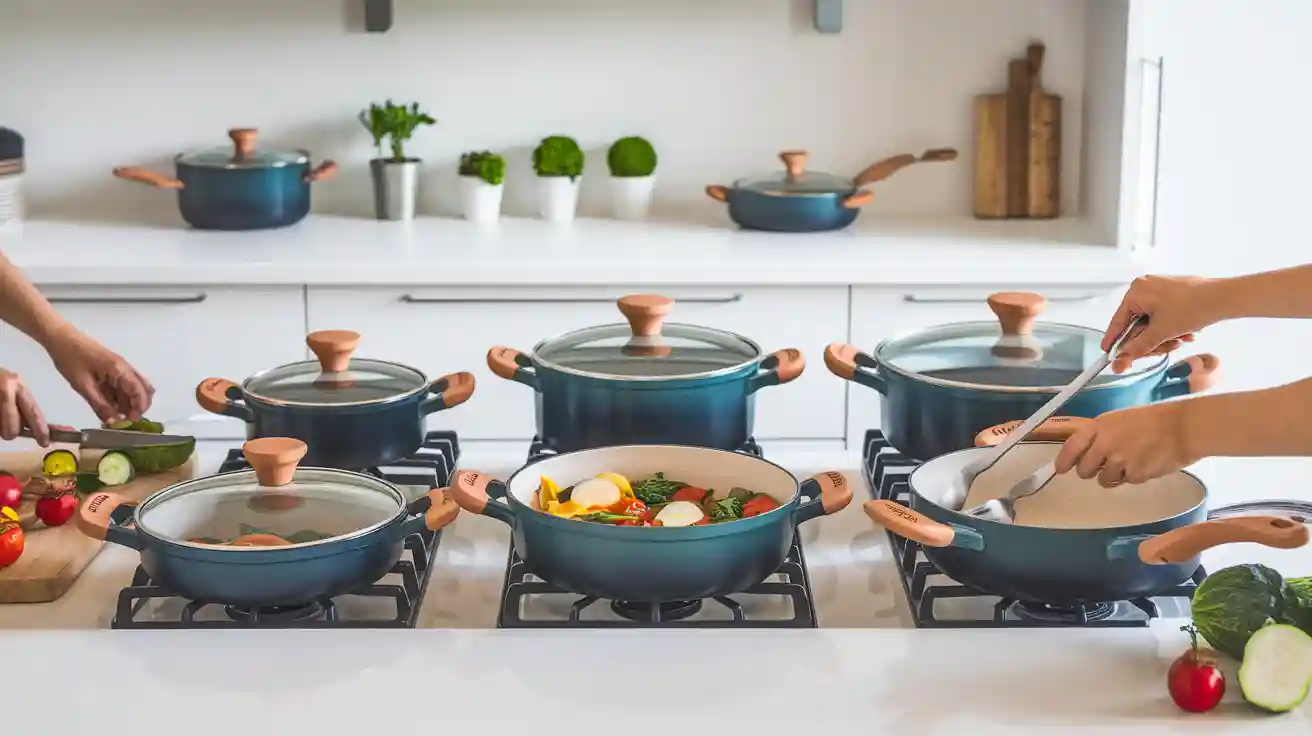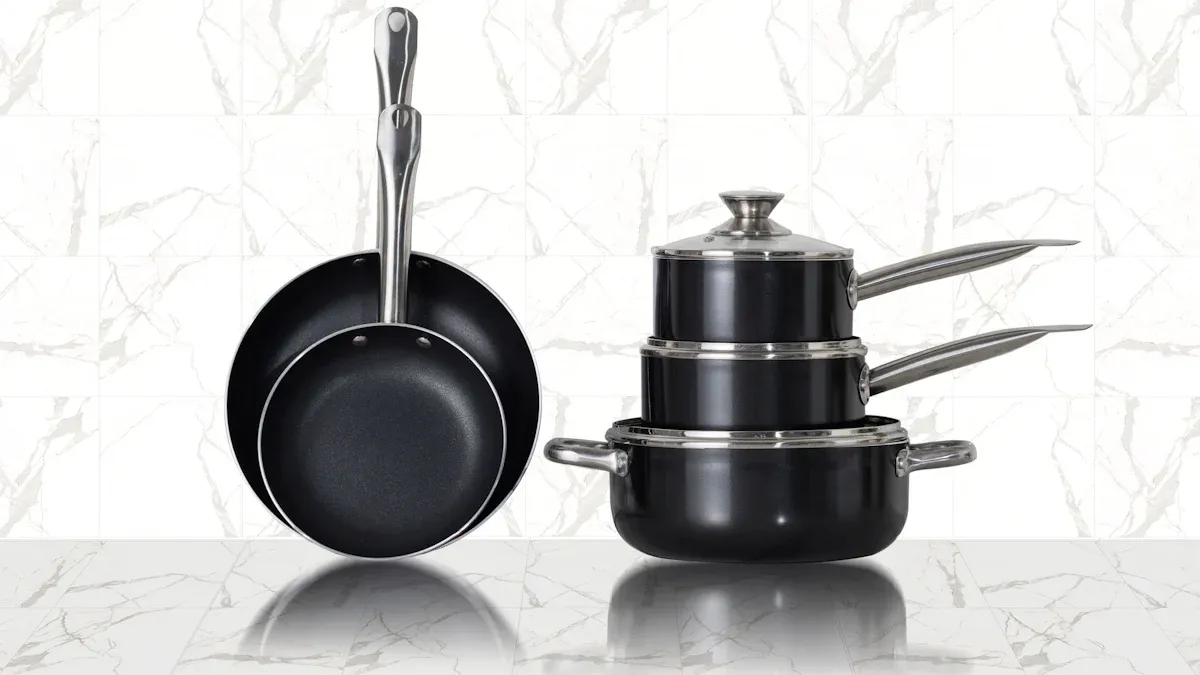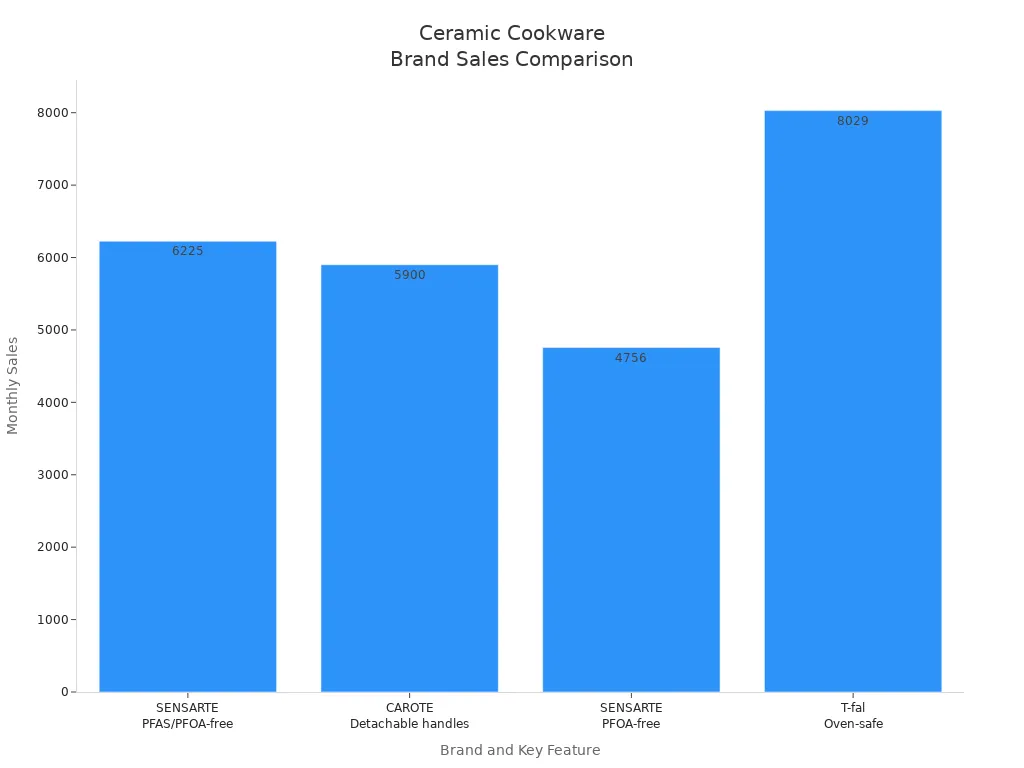
Choosing a ceramic cookware set helps you avoid health risks found in traditional pans. Many non-toxic ceramic cookware options protect you from harmful chemicals like PFAS and titanium dioxide. As a kitchen essential, non-toxic ceramic cookware supports healthier cooking, giving health-conscious cooks a safer cooking experience and making healthier cooking easy every day.
- Traditional cookware may contain:
- PFAS, linked to hormone problems and cancers.
- Titanium dioxide, which can harm organs if coatings get scratched.
Ceramic Cookware Set: The Kitchen Essential for Healthier Cooking
What Makes Ceramic Cookware Non-Toxic
You want to keep your family safe from harmful chemicals in the kitchen. Non-toxic ceramic cookware stands out because it does not contain dangerous substances found in many traditional pans. Most conventional cookware uses coatings or metals that can release toxins during cooking. Ceramic cookware sets avoid these risks by using natural minerals and high-temperature firing, which creates a smooth, non-porous surface.
Here is a table showing the most common toxic substances in conventional cookware and their absence in ceramic cookware:
| Toxic Substance | Health Risks | Found in Conventional Cookware | Found in Ceramic Cookware |
|---|---|---|---|
| PTFE (Teflon) | Releases toxic fumes, causes illness | Yes | No |
| PFOA | Linked to cancer, liver and thyroid issues | Yes | No |
| GenX (PFAS) | Similar toxicity to PFOA | Yes | No |
| Aluminum | Neurotoxin, can leach into food | Yes | No |
| Copper | Can cause liver/kidney damage | Yes | No |
| Lead | Severe health effects, especially in children | Sometimes | Generally No* |
*Note: Certified non-toxic ceramic cookware sets are tested to ensure they do not leach lead or cadmium, making them a safer choice for your kitchen.
Manufacturers of pure ceramic cookware use only natural minerals and avoid synthetic chemicals like PFAS, PTFE, and heavy metals. They fire the cookware at high temperatures, which locks in the materials and prevents leaching. Many brands also use third-party testing to confirm their products meet strict safety standards, such as California Proposition 65 and FDA guidelines. This process ensures you get a kitchen essential that supports healthier cooking every day.
Health and Safety Benefits of Ceramic Cookware
When you choose a ceramic cookware set, you protect yourself from many health risks. Non-toxic ceramic cookware does not release harmful fumes, even at high temperatures. You avoid exposure to chemicals like PFAS, PTFE, and PFOA, which are linked to cancer, hormone problems, and organ damage. Health-conscious cooks prefer non-toxic cookware options because they want peace of mind while preparing meals.
Certified ceramic cookware sets also reduce your risk of heavy metal exposure. Modern products that meet FDA and California Proposition 65 standards have strict limits for lead and cadmium. Studies show that ceramic and glass cookware leach fewer heavy metals than other materials, especially when you use undamaged, certified products. You can cook with confidence, knowing your food stays free from dangerous substances.
Tip: Always check for certifications like NSF International, FDA approval, and California Proposition 65 compliance when buying ceramic cookware. These labels show the product has passed safety tests for food contact.
Ceramic cookware also supports a healthier planet. As eco-friendly cookware, it avoids persistent chemicals that pollute water and harm wildlife. Some brands use renewable materials and green manufacturing, making your cooking experience better for both your family and the environment.
How Ceramic Cookware Enhances Food Quality and Taste
Non-toxic ceramic cookware does more than keep your food safe. It also helps you enjoy better taste and nutrition. The smooth, non-reactive surface of ceramic cookware means it will not change the flavor of your food, even when you cook with acidic ingredients like tomatoes or lemon. You get the true taste of your recipes every time.
Studies show that ceramic cookware preserves nutrients better than reactive metals. For example:
- Omega-3 fatty acids stay 20-35% higher in foods cooked with ceramic.
- Antioxidants and vitamin E break down less, so your meals keep more of their healthy benefits.
- Harmful compounds like trans fats and polycyclic aromatic hydrocarbons form less often on ceramic surfaces.
Culinary experts praise ceramic cookware for its exceptional nonstick performance. You can cook eggs, pancakes, and fish without sticking, which keeps their texture and flavor just right. While ceramic cookware works best at low to medium heat, it excels at slow cooking methods that bring out deep flavors in stews, soups, and sauces.
Note: Ceramic cookware is not ideal for high-heat searing or browning, but it shines when you want gentle, even cooking and easy cleanup.
By choosing a non-toxic ceramic cookware set, you upgrade your cooking experience and make healthier cooking simple and enjoyable. You get peace of mind, better-tasting food, and a safer kitchen for everyone.
Choosing the Right Ceramic Cookware Set for Your Kitchen

Key Features to Look For in a Kitchen Essential
When you shop for a ceramic cookware set, focus on features that make your cooking experience safer and more enjoyable. Look for non-toxic ceramic cookware with advanced coating technology, such as Inoceram Glide, which is 20 times harder than basic coatings. Choose sets with a durable construction, like recycled aluminum bodies and stainless steel induction bases. These features help your pans heat evenly and last longer. Handles should feel secure and comfortable, and vented glass lids let you check your food without losing heat. Many top brands, such as SENSARTE and CAROTE, offer these benefits and lead in consumer reviews and sales.
| Brand | Monthly Sales | Key Features |
|---|---|---|
| SENSARTE | 6,225 | PFAS/PFOA-free, induction-compatible |
| CAROTE | 5,900 | Detachable handles, RV-friendly |
| T-fal | 8,029 | Oven-safe, dishwasher-safe |

Matching Your Ceramic Cookware Set to Your Cooking Needs
You want a set that fits your style. Large sets with many pieces cover boiling, sautéing, and baking. Smaller sets work well for simple meals or small kitchens. Non-toxic ceramic cookware comes in many shapes and sizes, so you can simmer, fry, or bake with ease. Skillets are great for frying eggs, while Dutch ovens help with slow-cooked stews. Many sets move from oven to table, making serving easy.
Tips for Healthier Cooking and Long-Lasting Performance
To get the most from your non-toxic ceramic cookware, use low to medium heat. This protects the coating and keeps your meals healthy. Always let pans cool before washing. Clean with soft sponges and mild soap to keep your cookware easy to clean and looking new. Use wooden or silicone utensils to avoid scratches. Store your pans with care to prevent chips and cracks. With gentle handling and proper care, your cookware’s durable construction will support healthier cooking for years.
You can upgrade your kitchen and support healthier cooking by choosing non-toxic ceramic cookware. Many users praise the easy cleaning and even heating.
“The non-stick surface is incredible — I barely need any oil, and nothing sticks.” – Sarah T., Verified Buyer
Make the switch for a safer, more enjoyable cooking experience.
FAQ
What utensils should you use with ceramic cookware?
You should use wooden, silicone, or plastic utensils. These help prevent scratches and keep your ceramic coating in good shape.
Can you put ceramic cookware in the dishwasher?
You can put most ceramic cookware in the dishwasher. Hand washing helps your pans last longer and keeps the nonstick surface working well.
Does ceramic cookware work on induction cooktops?
Some ceramic cookware sets have induction-compatible bases. Always check the product label or look for an induction symbol before you buy.


